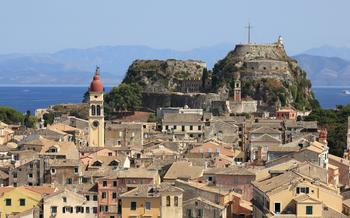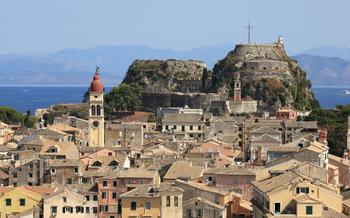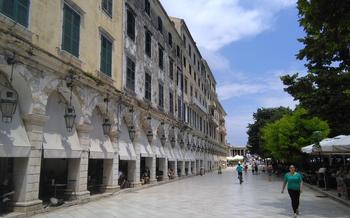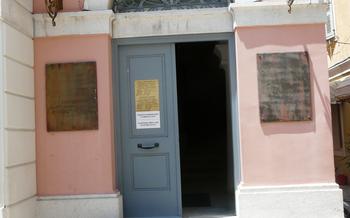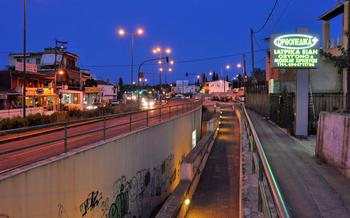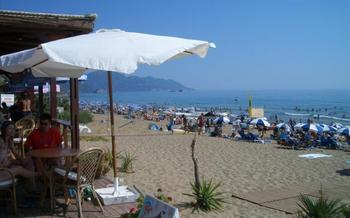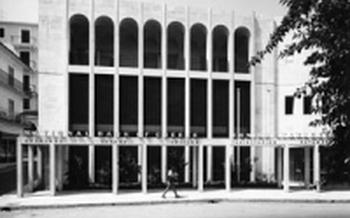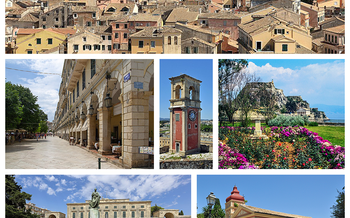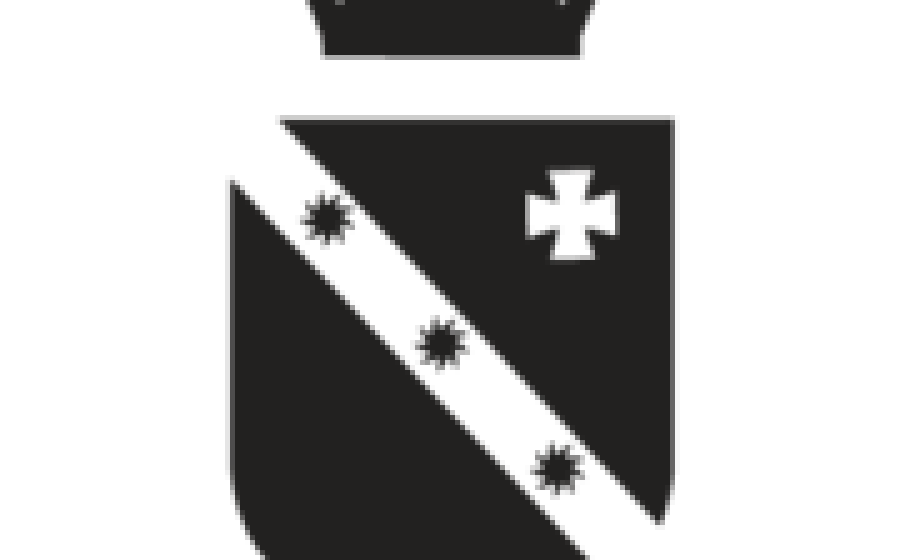
Kapodistrias Museum
- Historical Significance
- Location
- Architecture
- Exhibits
- Interactive Displays
- Guided Tours
- Educational Programs
- Museum Shop
- Hours of Operation
- Admission Fees
- Accessibility
- Nearby Attractions
- Best Time to Visit
- Photography Policy
- Insider Tip:
Historical Significance
During the 19th century, Corfu found itself at the forefront of modern Greek history, serving as a significant hub for the Greek War of Independence. The island played a pivotal role in shaping the political and cultural landscape of modern Greece, and one of the key figures of this era was Ioannis Kapodistrias.
Born in Corfu in 1776, Kapodistrias emerged as a prominent statesman and diplomat, dedicating his life to the liberation of Greece from Ottoman rule. He served as the first governor of independent Greece from 1827 to 1831, playing a crucial role in establishing the foundations of the modern Greek state. Kapodistrias' legacy extends far beyond his political achievements; he was also a visionary reformer, introducing progressive policies and institutions that laid the groundwork for Greece's development as a modern nation-state.
Location
The Kapodistrias Museum is located in the heart of Corfu Town, at 11 Kapodistriou Street, in a stately neoclassical building that once served as the residence of the first governor of modern Greece, Ioannis Kapodistrias. The museum is easily accessible, whether you choose to explore Corfu's rich history and culture on foot or take advantage of the island's efficient public transportation network.
To get to the museum by public transportation, take the No. 1 bus from the Corfu Town bus station and disembark at the "Liston" stop, which is just a short walk from the museum. From the bus stop, turn right onto Kapodistriou Street and proceed for about 100 meters until you see the museum on your left. Alternatively, you can opt for a leisurely stroll from the center of Corfu Town, taking in the sights and sounds of this vibrant city, and reach the museum in approximately 15 minutes.
Architecture
The Kapodistrias Museum is housed in the former residence of Ioannis Kapodistrias, a remarkable figure in Greek history who served as the first governor of Greece. Built in the 18th century, the building stands as an impressive testament to the architectural style prevalent during that era, known as Venetian Baroque. This style incorporates elements of both Renaissance and Baroque architecture, characterized by intricate ornamentation and an emphasis on symmetry.
The museum's façade showcases intricate details, with arched windows and doorways adorned with decorative carvings. The use of pastel colors enhances the overall aesthetic, lending a sense of warmth and elegance to the building. The interior of the museum has been carefully restored to reflect the original grandeur of the residence. Visitors can admire the well-preserved frescoes, intricate moldings, and gleaming marble floors that grace the various rooms.
One notable feature of the building is its central courtyard, which serves as a tranquil oasis amidst the bustling city. Surrounded by graceful arches and lush greenery, the courtyard provides a serene setting for visitors to pause and reflect on the life and legacy of Ioannis Kapodistrias. The museum's architecture seamlessly blends historical charm with modern functionality, creating a space that is both captivating and educational.
Exhibits
The Kapodistrias Museum houses a diverse collection of artifacts that provide a comprehensive overview of the life and achievements of Ioannis Kapodistrias. Personal belongings, such as clothing, furniture, and travel items, offer a glimpse into his daily life. Visitors can also view an impressive collection of manuscripts, including Kapodistrias's diplomatic correspondence, political writings, and personal diaries. These documents provide valuable insights into his political philosophy, diplomatic strategies, and personal reflections.
Among the highlights of the museum's collection are the original Greek Constitution of 1822, drafted by Kapodistrias and his advisors, and the pen he used to sign the document. Other notable exhibits include a portrait of Kapodistrias by the renowned Greek artist Nikolaos Gyzis, as well as a collection of medals and awards bestowed upon him in recognition of his contributions to Greece.
The museum also features a section dedicated to the Ionian Academy, which Kapodistrias founded in 182This section showcases documents, artifacts, and images related to the academy's history, curriculum, and impact on Greek education.
The exhibits are presented in a chronological order, allowing visitors to trace the trajectory of Kapodistrias's life and career from his early years as a diplomat in the Russian Empire to his tenure as the first governor of independent Greece. Informative panels and interactive displays accompany the exhibits, providing additional context and historical background.
Interactive Displays
Although the Kapodistrias Museum doesn't offer immersive multimedia presentations or interactive exhibits, its traditional display approach allows visitors to engage with history on a personal level. Through carefully curated exhibits and informative panels, the museum invites visitors to delve into the life and legacy of Ioannis Kapodistrias. The well-preserved artifacts, such as personal belongings and manuscripts, speak volumes about Kapodistrias' dedication to Greece and his role in shaping the nation's destiny.
The museum's collection is presented in a clear and accessible manner, making it easy for visitors of all ages to understand and appreciate the historical significance of the exhibits. While the museum may not have cutting-edge interactive displays, the authenticity and poignancy of the artifacts themselves create a powerful connection to the past, leaving a lasting impression on visitors.
Guided Tours
The Kapodistrias Museum offers guided tours to enhance the visitor experience. These tours are conducted by knowledgeable and passionate guides who provide in-depth insights into the life and achievements of Ioannis Kapodistrias. The tours are available in several languages to cater to international visitors.
The cost of a guided tour is typically included in the admission fee. Visitors can choose to take a guided tour at the beginning of their visit to gain a comprehensive overview of the museum's exhibits. Alternatively, they can opt for a guided tour later in their visit to delve deeper into specific aspects of Kapodistrias' life and work.
The benefits of taking a guided tour are numerous. Firstly, the guides can provide historical context and anecdotes that bring the exhibits to life. Secondly, they can answer questions and clarify any doubts that visitors may have. Thirdly, guided tours help visitors navigate the museum efficiently, ensuring that they make the most of their time.
Educational Programs
The Kapodistrias Museum offers a variety of educational programs and workshops that cater to different age groups and interests. These programs aim to engage visitors with the life and legacy of Ioannis Kapodistrias and the history of Corfu during the 19th century.
Programs for School Groups
The museum offers guided tours and workshops specifically designed for school groups of all ages. These programs are aligned with the Greek national curriculum and provide students with an immersive learning experience. Students can explore the museum's exhibits, participate in hands-on activities, and learn about the significance of Kapodistrias' contributions to modern Greece.
Workshops for Adults
The museum also hosts workshops for adults interested in delving deeper into the history and culture of Corfu. These workshops cover various topics, such as traditional Corfiot cuisine, local crafts, and the history of the island's Venetian fortifications. Participants can engage with experts in these fields, learn new skills, and gain a deeper understanding of Corfu's rich heritage.
How to Participate
To participate in the museum's educational programs, visitors can contact the museum directly to inquire about available dates and times. The museum staff is happy to assist with reservations and provide any additional information. These programs offer a unique opportunity for visitors to engage with the museum's collection and learn about the fascinating history of Corfu and its role in modern Greek history.
Museum Shop
The Kapodistrias Museum features a well-stocked museum shop that offers a diverse range of items to cater to the interests of visitors. Here, you can find an array of souvenirs to commemorate your visit, including postcards, magnets, and keychains adorned with images of Corfu and the museum.
For those seeking a deeper understanding of Ioannis Kapodistrias and his contributions to modern Greek history, the museum shop offers a selection of books and publications. These include biographies, historical accounts, and academic studies that delve into the life and achievements of this remarkable figure.
In addition to souvenirs and books, the museum shop also showcases replicas of artifacts and historical documents related to Kapodistrias. These replicas provide visitors with a tangible connection to the past and offer a glimpse into the world of this influential statesman.
The merchandise at the museum shop is reasonably priced, allowing visitors to take home a piece of their Corfu experience without breaking the bank. The quality of the items is also commendable, ensuring that your souvenirs will last for years to come.
Hours of Operation
The Kapodistrias Museum is open to the public six days a week, from Tuesday to Sunday. Its doors remain closed on Mondays, allowing for maintenance and preparation for the upcoming week. During the summer season, from April to October, the museum welcomes visitors from 8:30 AM to 3:00 PM. As the days grow shorter and the weather cools, the winter hours come into effect from November to March, with the museum operating from 8:30 AM to 2:30 PM. It's worth noting that the museum observes Greek public holidays and may have adjusted hours or closures on these days. To avoid any inconvenience, it's advisable to check the museum's website or contact them directly for the most up-to-date information on their operating hours.
Admission Fees
Admission fees for the Kapodistrias Museum are quite reasonable, making it accessible to visitors from all backgrounds. Adults can enter for a fee of 4 euros, while children and students receive a discounted rate of 2 euros. It's worth noting that admission is free for visitors with disabilities and their companions.
For those seeking a more comprehensive experience, guided tours are available at an additional cost. These tours provide a deeper insight into the life and legacy of Ioannis Kapodistrias, as well as the historical context of the museum's exhibits. The cost of a guided tour varies depending on the group size and language preferences.
Payment for admission and guided tours can be made in cash or by card at the museum's ticket counter. It's always advisable to carry both options to ensure a smooth and hassle-free entry.
Accessibility
The Kapodistrias Museum is committed to providing an inclusive and accessible environment for all visitors, regardless of their abilities or disabilities. The museum features a variety of accessibility features to ensure that everyone can enjoy their visit.
Visitors with disabilities can easily access the museum through the main entrance, which is equipped with a ramp and automatic doors. Inside the museum, there are elevators that provide access to all floors, including the ground floor, where the museum shop and restrooms are located.
The museum also offers accessible restrooms that are equipped with grab bars, raised toilet seats, and emergency call buttons. All of the exhibits in the museum are presented in a clear and concise manner, with large fonts and easy-to-read labels. Additionally, the museum provides wheelchairs for visitors who may need assistance getting around.
For visitors who are deaf or hard of hearing, the museum offers sign language interpreters upon request. Visitors can also request audio guides that are equipped with closed captioning. The museum staff is also trained to assist visitors with disabilities and can provide additional information or assistance as needed.
Nearby Attractions
The Kapodistrias Museum is conveniently situated within walking distance of several other notable attractions in Corfu Town. For history buffs, the Corfu Old Town with its Venetian fortifications and narrow streets is a must-see. The Old Town is a UNESCO World Heritage Site and is home to various historical landmarks, including the Corfu Palace, the ruins of the Old Venetian Fortress, and the Jewish Quarter.
For those interested in art and culture, the Corfu Museum of Asian Art, the Municipal Art Gallery, and the Corfu Public Library are all within a short walk from the Kapodistrias Museum. These institutions offer a diverse range of exhibits, from traditional Greek art to contemporary international works.
If you're seeking a respite from the urban environment, the lush greenery of the Corfu Botanical Garden is just a short bus ride away. The garden boasts a vast collection of plants from around the world, including rare and endangered species, and offers a peaceful oasis in the heart of the city.
To create an enriching itinerary, consider combining a visit to the Kapodistrias Museum with other nearby attractions based on your interests. For example, you could explore the Old Town in the morning, visit the Kapodistrias Museum in the afternoon, and end the day with a stroll through the Corfu Botanical Garden.
Best Time to Visit
The best time to visit the Kapodistrias Museum is during the shoulder seasons, which fall between April and May and September and October. During these months, the weather is mild and pleasant, with average temperatures ranging from 15 to 25 degrees Celsius. The crowds are also smaller, allowing you to explore the museum at your own pace and enjoy a more intimate experience.
In the summer months, Corfu can get quite hot and crowded, with temperatures often exceeding 30 degrees Celsius. If you do choose to visit during this time, be sure to plan your visit accordingly and avoid the hottest hours of the day. The museum is air-conditioned, but it can still get stuffy and uncomfortable if the crowds are large.
The winter months can be quite cold and rainy in Corfu, with temperatures dropping to around 10 degrees Celsius. However, the museum is still open during this time, and you may find that you have the place to yourself. If you don't mind the cold weather, this can be a great time to visit the museum and learn about the life and legacy of Ioannis Kapodistrias.
Photography Policy
The Kapodistrias Museum encourages visitors to capture their memories through photography, but certain guidelines must be followed to ensure the preservation of the exhibits and the privacy of other visitors. Photography and videography are generally permitted within the museum, but flash photography is strictly prohibited to protect the delicate artifacts from damage. Visitors are requested to be mindful of the potential impact of their actions on other guests and to avoid blocking exhibits or disrupting the flow of traffic.
While capturing cherished moments, it is essential to respect the privacy of fellow visitors. Refrain from taking photographs or videos that may intentionally or unintentionally include other individuals without their consent. The museum's staff is always willing to assist visitors in finding the best angles and vantage points while maintaining the privacy of others.
Insider Tip:
For a unique photo opportunity, head to the museum's rooftop terrace. From here, you can capture stunning panoramic views of Corfu Town, the Ionian Sea, and the surrounding countryside. This hidden gem is the perfect spot to end your visit and take home a lasting memory of your time at the Kapodistrias Museum.
